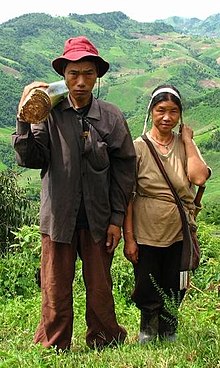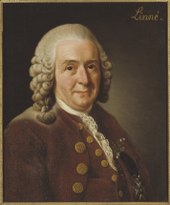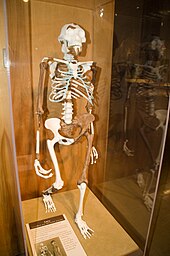
A | B | C | D | E | F | G | H | CH | I | J | K | L | M | N | O | P | Q | R | S | T | U | V | W | X | Y | Z | 0 | 1 | 2 | 3 | 4 | 5 | 6 | 7 | 8 | 9
| Human[1] | |
|---|---|

| |
| Male (left) and female (right) adult humans, Thailand, 2007 | |
| Scientific classification | |
| Domain: | Eukaryota |
| Kingdom: | Animalia |
| Phylum: | Chordata |
| Class: | Mammalia |
| Order: | Primates |
| Suborder: | Haplorhini |
| Infraorder: | Simiiformes |
| Family: | Hominidae |
| Subfamily: | Homininae |
| Tribe: | Hominini |
| Genus: | Homo |
| Species: | H. sapiens
|
| Binomial name | |
| Homo sapiens | |

| |
| Homo sapiens population density (2005) | |
Humans (Homo sapiens) or modern humans are the most common and widespread species of primate, and the last surviving species of the genus Homo. They are great apes characterized by their hairlessness, bipedalism, and high intelligence. Humans have large brains, enabling more advanced cognitive skills that enable them to thrive and adapt in varied environments, develop highly complex tools, and form complex social structures and civilizations. Humans are highly social, with individual humans tending to belong to a multi-layered network of cooperating, distinct, or even competing social groups – from families and peer groups to corporations and political states. As such, social interactions between humans have established a wide variety of values, social norms, languages, and traditions (collectively termed institutions), each of which bolsters human society. Humans are also highly curious: the desire to understand and influence phenomena has motivated humanity's development of science, technology, philosophy, mythology, religion, and other frameworks of knowledge; humans also study themselves through such domains as anthropology, social science, history, psychology, and medicine. As of April 2024, there are estimated to be more than 8 billion humans alive.
Although some scientists equate the term "humans" with all members of the genus Homo, in common usage it generally refers to Homo sapiens, the only extant member. All other members of the genus Homo, which are now extinct, are known as archaic humans, and the term "modern human" is used to distinguish Homo sapiens from archaic humans. Anatomically modern humans emerged around 300,000 years ago in Africa, evolving from Homo heidelbergensis or a similar species. Migrating out of Africa, they gradually replaced and interbred with local populations of archaic humans. Multiple hypotheses for the extinction of archaic human species such as Neanderthals include competition, violence, interbreeding with Homo sapiens, or inability to adapt to climate change.
For most of their history, humans were nomadic hunter-gatherers. Humans began exhibiting behavioral modernity about 160,000–60,000 years ago. The Neolithic Revolution, which began in Southwest Asia around 13,000 years ago (and separately in a few other places), saw the emergence of agriculture and permanent human settlement; in turn, this led to the development of civilization and kickstarted a period of continuous (and ongoing) population growth and rapid technological change. Since then, a number of civilizations have risen and fallen, while a number of sociocultural and technological developments have resulted in significant changes to the human lifestyle.
Genes and the environment influence human biological variation in visible characteristics, physiology, disease susceptibility, mental abilities, body size, and life span. Though humans vary in many traits (such as genetic predispositions and physical features), humans are among the least genetically diverse primates. Any two humans are at least 99% genetically similar. Humans are sexually dimorphic: generally, males have greater body strength and females have a higher body fat percentage. At puberty, humans develop secondary sex characteristics. Females are capable of pregnancy, usually between puberty, at around 12 years old, and menopause, around the age of 50.
Humans are omnivorous, capable of consuming a wide variety of plant and animal material, and have used fire and other forms of heat to prepare and cook food since the time of Homo erectus. Humans can survive for up to eight weeks without food and several days without water. Humans are generally diurnal, sleeping on average seven to nine hours per day. Childbirth is dangerous, with a high risk of complications and death. Often, both the mother and the father provide care for their children, who are helpless at birth.
Humans have a large, highly developed, and complex prefrontal cortex, the region of the brain associated with higher cognition. Humans are highly intelligent and capable of episodic memory; they have flexible facial expressions, self-awareness, and a theory of mind. The human mind is capable of introspection, private thought, imagination, volition, and forming views on existence. This has allowed great technological advancements and complex tool development through complex reasoning and the transmission of knowledge to subsequent generations through language.
Etymology and definition

All modern humans are classified into the species Homo sapiens, coined by Carl Linnaeus in his 1735 work Systema Naturae.[2] The generic name "Homo" is a learned 18th-century derivation from Latin homō, which refers to humans of either sex.[3][4] The word human can refer to all members of the Homo genus.[5] The name "Homo sapiens" means 'wise man' or 'knowledgeable man'.[6] There is disagreement if certain extinct members of the genus, namely Neanderthals, should be included as a separate species of humans or as a subspecies of H. sapiens.[5]
Human is a loanword of Middle English from Old French humain, ultimately from Latin hūmānus, the adjectival form of homō ('man' – in the sense of humanity).[7] The native English term man can refer to the species generally (a synonym for humanity) as well as to human males. It may also refer to individuals of either sex.[8]
Despite the fact that the word animal is colloquially used as an antonym for human,[9] and contrary to a common biological misconception, humans are animals.[10] The word person is often used interchangeably with human, but philosophical debate exists as to whether personhood applies to all humans or all sentient beings, and further if one can lose personhood (such as by going into a persistent vegetative state).[11]
Evolution
Humans are apes (superfamily Hominoidea).[12] The lineage of apes that eventually gave rise to humans first split from gibbons (family Hylobatidae) and orangutans (genus Pongo), then gorillas (genus Gorilla), and finally, chimpanzees and bonobos (genus Pan). The last split, between the human and chimpanzee–bonobo lineages, took place around 8–4 million years ago, in the late Miocene epoch.[13][14] During this split, chromosome 2 was formed from the joining of two other chromosomes, leaving humans with only 23 pairs of chromosomes, compared to 24 for the other apes.[15] Following their split with chimpanzees and bonobos, the hominins diversified into many species and at least two distinct genera. All but one of these lineages – representing the genus Homo and its sole extant species Homo sapiens – are now extinct.[16]

The genus Homo evolved from Australopithecus.[17][18] Though fossils from the transition are scarce, the earliest members of Homo share several key traits with Australopithecus.[19][20] The earliest record of Homo is the 2.8 million-year-old specimen LD 350-1 from Ethiopia, and the earliest named species are Homo habilis and Homo rudolfensis which evolved by 2.3 million years ago.[20] H. erectus (the African variant is sometimes called H. ergaster) evolved 2 million years ago and was the first archaic human species to leave Africa and disperse across Eurasia.[21] H. erectus also was the first to evolve a characteristically human body plan. Homo sapiens emerged in Africa around 300,000 years ago from a species commonly designated as either H. heidelbergensis or H. rhodesiensis, the descendants of H. erectus that remained in Africa.[22] H. sapiens migrated out of the continent, gradually replacing or interbreeding with local populations of archaic humans.[23][24][25] Humans began exhibiting behavioral modernity about 160,000–70,000 years ago,[26] and possibly earlier.[27]
The "out of Africa" migration took place in at least two waves, the first around 130,000 to 100,000 years ago, the second (Southern Dispersal) around 70,000 to 50,000 years ago.[28][29] H. sapiens proceeded to colonize all the continents and larger islands, arriving in Eurasia 125,000 years ago,[30][31] Australia around 65,000 years ago,[32] the Americas around 15,000 years ago, and remote islands such as Hawaii, Easter Island, Madagascar, and New Zealand in the years 300 to 1280 CE.[33][34]
Human evolution was not a simple linear or branched progression but involved interbreeding between related species.[35][36][37] Genomic research has shown that hybridization between substantially diverged lineages was common in human evolution.[38] DNA evidence suggests that several genes of Neanderthal origin are present among all non sub-Saharan-African populations, and Neanderthals and other hominins, such as Denisovans, may have contributed up to 6% of their genome to present-day non sub-Saharan-African humans.[35][39][40]
Human evolution is characterized by a number of morphological, developmental, physiological, and behavioral changes that have taken place since the split between the last common ancestor of humans and chimpanzees. The most significant of these adaptations are hairlessness,[41] obligate bipedalism, increased brain size and decreased sexual dimorphism (neoteny). The relationship between all these changes is the subject of ongoing debate.[42]
